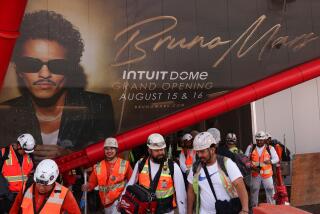Report says proposed Clippers arena might adversely impact traffic
The billion-dollar arena complex the Clippers want to build in Inglewood took another step forward Friday with the release of the draft environmental report for the project.
The report found that the privately financed Inglewood Basketball and Entertainment Center might create a “large number of significant and unavoidable transportation impacts,” but would add almost 1,000 full-time non-construction jobs in the city, and won’t contribute to gentrification or impact the viability of competing arenas in the region.
“We think the project that’s being shaped through this process is going to be the most fan-intensive basketball experience in the country,” said Chris Meany, the developer and project manager for the arena.
The complex would occupy 28 acres — including 22 controlled by the city — near the intersection of West Century Boulevard and South Prairie Avenue.
An 18,000-seat arena, featuring a sweeping roof that is designed to evoke the diamond shapes in a basketball net, anchors the development. Plans for the surrounding area include three parking garages, a practice facility, team offices, sports medicine clinic, hotel, retail space and a plaza.
Murphy’s Bowl LLC, the Clippers-controlled company behind the complex, hopes to start construction by July 2021 and complete the project in time for the 2024-25 season.
The sprawling Los Angeles Stadium and Entertainment District, centered around under-construction SoFi Stadium that will house the Rams and Chargers starting next year, is across the street.
The concentration of major venues — including a performance venue attached to the stadium and the Forum less than two miles away — fueled concerns about the project’s impact on traffic and transportation.
The report projected the arena will host 62 major events each year, including sold-out Clippers games and concerts. The events would cause “significant impacts” at 42 intersections in the hour before events and 11 intersections in the hour after events plus impacts on the 405 and 105 freeways.
A major event would bring an estimated 18,840 to 19,960 inbound and outbound vehicle trips, and would require adding 3,700 and 4,100 parking spaces at the L.A. Stadium and Entertainment District to supplement spaces in the arena’s three parking garages.
“There has been a bunch of work done to create a set of tools to manage traffic,” Meany said. “Our project is really focused on making sure (traffic) is limited to the hour or two before and after an event. … It leaves the city’s transit system better than it otherwise would have been.”
The report proposed a slew of Clippers-funded mitigation measures that include improvements to streets and traffic signals, widening freeway offramps, shuttles to Metro stations, programs to encourage biking or walking, incentives for carpools, and a park and ride program to connect the venue with lots in the region.
The 6-1 guard from Chicago demands that Ivica Zubac be well prepared for each opponent, pushing the 7-foot center from Croatia to maximize his potential.
In a statement, Inglewood Mayor James T. Butts Jr. said: “We know, better than any city our size in the U.S., how to properly manage and mitigate significant streams of traffic and other environmental impacts associated with sports and entertainment events.”
The arena complex will provide a net increase of 968 full-time non-construction jobs in Inglewood, according to the report, including 254 Clippers employees who would relocate to the new team headquarters.
Despite skyrocketing housing costs in Inglewood and the region — and lingering questions about the impact of the stadium development across the street on the prices — the report didn’t find a link between gentrification and sports facilities.
Before settling on the current site, the Clippers explored locations as far south as Long Beach, according to the report, in addition to several areas in Los Angeles including Boyle Heights and near Union Station. They also had discussions with owners of the Forum and the L.A. Stadium and Entertainment District, which is being developed by Rams owner Stan Kroenke.
The district avoided the environmental review process for the stadium through a ballot initiative that the Inglewood City Council adopted in February 2015. A previous plan to develop the site of the old Hollywood Park racetrack underwent environmental review in 2009.
The release of the report, which runs more than 10,000 pages and took 23 months to complete, starts a 45-day period for public comment. After the Inglewood City Council certifies the final environmental impact report — something that’s not expected to happen until late spring or early summer — that kicks off a 270-day window for legal challenges to the environmental review to be adjudicated.
Earlier this month, the California Air Resources Board certified the project as net carbon neutral and Gov. Gavin Newsom signed off on fast-tracking the arena complex under legislation passed last year to shield the project from drawn-out environmental litigation.
The project remains the target of three ongoing lawsuits in L.A. County Superior Court, two by the Madison Square Garden Co. and another by a group whose legal fees are being paid by the company that owns the Forum. Murphy’s Bowl countersued MSG last year.
“Even the most cursory review of the Clippers’ own analysis shows that the planned arena will be devastating for Inglewood, creating more than 40 significant and unavoidable environmental impacts during construction and operation, including harmful air pollution, noise and traffic impacts,” MSG said in a statement.
MSG alleged Inglewood committed fraud and violated its development agreement with the company in connection with the proposed arena. The city has repeatedly denied the claims. No trial date has been set.
“If we can all cooperate,” Meany said, “if we can all get past the silliness and pettiness we’ve been in, then we can get back to being good neighbors like we should be.”
More to Read
Get our high school sports newsletter
Prep Rally is devoted to the SoCal high school sports experience, bringing you scores, stories and a behind-the-scenes look at what makes prep sports so popular.
You may occasionally receive promotional content from the Los Angeles Times.








